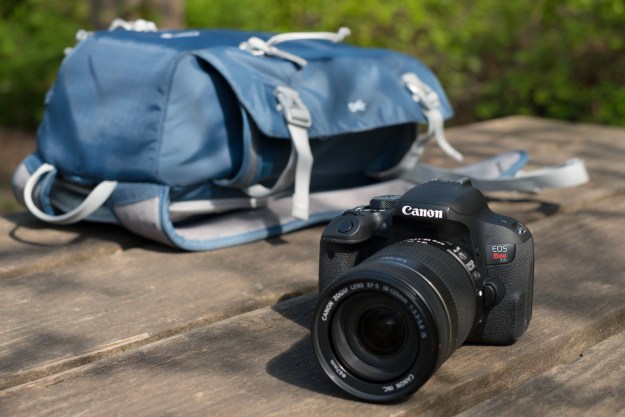When Canon unveiled more details about its upcoming EOS R5 mirrorless camera today, it touted an over-the-top 8K video mode. I expect the R5 will be an impressive camera that may just shoot Canon’s EOS R series ahead of Nikon, Sony, and Panasonic in the full-frame mirrorless game, but Canon has yet to detail its still-photo capabilities. Instead, all attention is focused on that buzzworthy term, 8K.
It’s all hype.
Yes, the R5 is a professional camera, but its arrival will usher in a new era for video content. It won’t be long before Costco and Walmart are lining shelves with lower-tier models emblazoned with an 8K logo.

Don’t get me wrong. I’m not anti-8K. I think there’s a place for 8K displays. These displays, when combined with HDR (high dynamic range), would make an excellent medium for displaying photographs — perhaps even better than print.
I just don’t think that an 8K video camera makes a lot of sense. Not for the average person, and not even the average professional videographer.
Seeing is believing
Whether or not the human eye can see the 8K difference is debatable. Some scientific testing says it can, but this testing was performed with static on-screen objects. Research also points to human vision’s ability to perceive the scan lines in a 4K display, rather than pixelation in the content itself.
You might see a similar effect in a movie theater with digital projector, where the pixel grid can become visible. Usually, the movie will mask this, but you might still notice it in large, bright areas, especially if you’re closer to the screen. I last noticed this during an IMAX screening of Avengers: Endgame.
This, it would seem, is a justification for 8K — but that’s a misunderstanding. The problem isn’t the resolution of the content, but rather the display medium. The pixel grid would be visible even if no content is displayed and the projector is projecting white light. A higher-resolution projector could solve the issue, but you wouldn’t necessarily need a higher-resolution copy of the film.
In fact, Endgame, like most films, was mastered in 2K.
Why is this? Movies, particularly those that are special-effects-heavy, would take much longer to complete if mastered at
Resolution ≠ image quality
There’s an informative and entertaining comparison on pro video YouTube channel Extrashot titled “Can 4K be better than 8K?” For video geeks, it’s absolutely worth a watch, whether for the host’s warm, Bob Ross-like delivery style, or just to see two middle-aged men go completely giddy over the thinness of an OLED panel.
I’ll summarize: In a blind test, the two viewers picked a
In this case, it was the display technology — not the number of pixels — that had the larger impact on image quality. OLED, with its pure blacks, has a broader effective dynamic range and better contrast modulation, which can actually make it sharper than an 8K TV.
This is also true in cameras. A camera with a better sensor that captures more dynamic range — or, one that gives you a robust video file type that keeps more of that dynamic range intact — will deliver a better picture. But dynamic range is a tricky thing to market, and an even trickier thing for content creators to master, so many customers don’t pay attention to it.
You can shoot
Did you have trouble following any of that? That’s why marketers want to stick to 8K.
Also, consider that a lot of content is consumed on mobile devices. Even when an 8K smartphone becomes reality, there’s no way you’ll be able to appreciate the extra sharpness (but you can already appreciate
While 8K has objectively four times as many pixels as
Bandwidth burdens and compression concerns
There are serious technical hurdles to making widespread 8K a reality, network bandwidth being one of them. Already, increased internet usage resulting from social distancing during the COVID-19 pandemic has led content providers to reduce streaming quality. With 8K potentially requiring four times the bandwidth of
The answer will likely come in the form of more efficient compression algorithms, perhaps ones built on machine learning. Beyond the internet, this is also important when it comes to how video is encoded in-camera. While the Canon EOS R5 will offer RAW 8K, such a high-bandwidth file type won’t work for anyone in the amateur space who doesn’t have buckets of money to spend on hard drives.
The top
Any advances in compression could also be applied to
Cutting-edge isn’t always best
Nevertheless, 8K is here. Eventually, you will end up buying an 8K-capable camera, perhaps without even realizing it. It will become the new normal.
But 8K shouldn’t be the reason you buy a camera — at least, not for the vast majority of us. It’s yet another marketing buzzword that clouds the truth of what really matters for image quality.
If you’re serious about producing high-quality video, I’d argue you can ignore spatial resolution altogether. For years, the top digital cinema camera in Hollywood was the Arri Alexa, with a resolution of 2.8K. Instead, look for greater bit depth (10 bit versus 8 bit) and color resolution (4:2:2 versus 4:2:0).
Or, you know, just tell a good story.
Editors' Recommendations
- Blackmagic Design’s new 12K cinema camera might actually make sense
- Don’t upgrade your camera. It won’t make you a better photographer
- The Canon EOS Rebel T8i brings 4K to a $750 budget DSLR
- QooCam, the first pocketable 8K 360 camera, is hiding some big features
- The future of 8K TVs is all about gaming. We’ll tell you why



